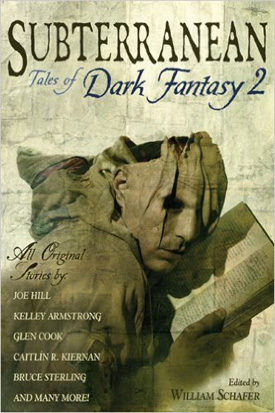 I don’t think I’m alone in thinking of “dark fantasy” as a sort of combination of urban fantasy and horror: vampires, werewolves, ghosts, zombies, and less pleasant creatures confronting more or less normal people who may have the resources, or just the dumb luck, to survive the encounter. Subterranean: Tales of Dark Fantasy 2 is not that. True, the stories all have a dark edge, but there are only two tales of werewolves and one of vampires, none of which have any of the classic trappings to them. So, these stories are not “dark fantasy” in that sense. What we have here is a mixture of the surreal, the outre, the mordant, and sometimes the hallucinatory.
I don’t think I’m alone in thinking of “dark fantasy” as a sort of combination of urban fantasy and horror: vampires, werewolves, ghosts, zombies, and less pleasant creatures confronting more or less normal people who may have the resources, or just the dumb luck, to survive the encounter. Subterranean: Tales of Dark Fantasy 2 is not that. True, the stories all have a dark edge, but there are only two tales of werewolves and one of vampires, none of which have any of the classic trappings to them. So, these stories are not “dark fantasy” in that sense. What we have here is a mixture of the surreal, the outre, the mordant, and sometimes the hallucinatory.
Out of a collection of eleven stories, all of which are at least capable, there are a few stand-outs. Kelley Armstrong’s “Chivalrous,” one of the werewolf stories, is a tight tale of betrayal, ruthlessness, and revenge deferred, set in modern-day Australia. In retrospect, it’s almost predictable, but so engaging that one doesn’t realize that until the story’s over. And the ending — well, one almost wants a sequel, until one realizes that a sequel would be beside the point.
“Hydraguros,” by Caitlín R. Kiernan, is nothing so much as a hallucination on the page, a story of life on the underbelly of the world, drug deals, “cleaning,” and liquid silver that makes its appearance in unexpected places, always disturbing. One is not sure if this story has a resolution or not, or whether it matters — it’s vividly drawn, surprisingly compelling, and puzzling enough to make it interesting. Or perhaps it is just a hallucination written down — but written down very well.
Norman Partridge’s “Vampire Lake” combines vampires, the Old West, and Apache legends into a story that probably comes the closest to horror in the entire collection. This comes close to being another hallucination, with an element of the surreal that takes it way beyond your typical vampire story. I should note that the vampires provide the pretext; the story is not about them. Partridge’s matter of fact, unadorned diction, in the person of the story’s narrator, provides an extra measure of immediacy.
I would be more than remiss if I didn’t mention Glen Cook’s “Smelling Danger.” It is classic Black Company, set in the time period when the Company is still in the service of the Lady, and Cook at his laconic best. We are in company with Croaker, who narrates, the wizards One-Eye and Goblin, who may have been unwittingly suborned by Limper, as well as Silent, who has not, and the Captain, who as usual is busy out-thinking everyone else. Needless to say, we are faced with layers of deception here, and an unreliable narrator: Croaker is being deceived as much as anyone else.
These are just the high points in a collection of solid stories. While I may quibble about the designation “dark fantasy,” I certainly have no other objections to the collection, save that I would have appreciated an editor’s introduction to provide some rationale for the selection. Lacking that, the stories have to stand on their own, which they do very well.
(Subterranean Press, 2011)
